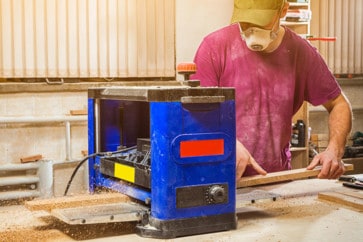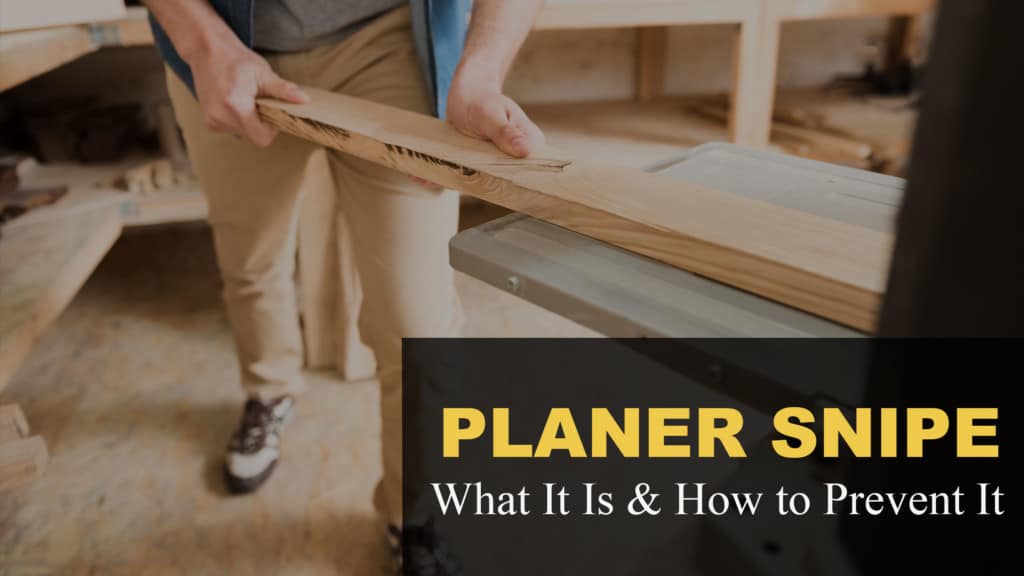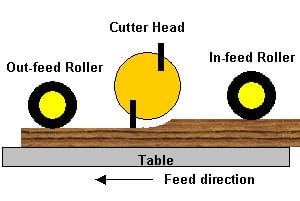If you do any woodworking, as an enthusiast or professional, you know the wood you get from the lumber yard is never going to be perfect. When using rough sawn lumber or even pallet wood, you’ll need to get the material smooth and to a consistent thickness before you can start working with it.
In order to get your lumber into a workable condition, you’re probably going to use a planer at some point.
Benchtop thickness planers are popular with woodworkers because they’re capable of handling most wood planing jobs you would need. They’re perfect for the home workshop as they’re compact and relatively inexpensive. The biggest drawback, is they’re prone to causing snipe.
And nothing is worse than having an expensive piece of hardwood ruined from snipe.
Let’s Dive Right In
ToolLogic.com earns a commission from purchases made through links in this post. Learn More
What is Planer Snipe?
The word snipe in woodworking refers to a deep cut in lumber that occurs at the leading and/or trailing end of the board. This occurs as it passes through a planer or jointer.
Snipe can be minor and only noticeable when applying finish, or it can be quite severe. On the extreme end, snipe can make deep gouges and irreversible damage to your workpiece.
What Causes Snipe?
In order to understand what causes snipe, you first have to briefly understand how planers work.
Planers have two pressure rollers located on both sides of the cutter head. These rollers are used to hold the board down so it makes consistent contact with the blade as it moves through the machine.
The problem is, when a board is initially fed into the planer, it’s only being held down by the infeed roller. That causes the workpiece to lift slightly into the cutting blade making the first 3-4 inches of the board to be thinner than the rest.
When a board exits the planer, the same problem occurs. Now, only the outfeed roller, located after the blade, is holding the board in place. That lifts the tail end of the board into the blade, causing it to be thinner than the rest.
How to Prevent Planer Snipe
Lift It Up
Ideally, you’ll have infeed and outfeed tables leveled with the height of the planer table and long enough to fully support the lumber you are planing.

I don’t know about you, but I don’t have unlimited space in my workshop, so that isn’t entirely possible.
In that case, one of the simplest ways to prevent snipe is to lift up the backend of a board as it makes contact with the cutter head. This helps to make sure the front end of the board is in contact with the table of the planer and makes even contact with the cutter. You’ll want to do the same thing as it exits the planer too.
Use Sacrificial Boards Before and After
One way to reduce sniping is to use sacrificial boards before and after you put your workpieces through. The concept here is that the first and trailing boards help even out the pressure from the rollers, leaving your workpiece smooth and with even cuts.
Use Spare Side Runners
Similar to using scrap pieces of wood before and after your workpiece, you can use side runners to help prevent snipe. Simply attach strips of scrap wood to each side of your workpiece. These support rails should be about a foot longer than your workpiece but about the same thickness. They’ll absorb all of the snipe and leave you with perfect boards every time.
Perform Regular Maintenance
All mechanical equipment will last far longer and give you better results when it’s properly maintained and tuned up.
Keep your planer’s cutter head clean, flat and smooth. Check the rest of the planer equipment for sappy residue, lubricant buildup, dust, and wood chips.
Apply some finishing paste wax to the table of the planer to help the wood pass smoothly under the cutter. That can also help reduce snipe.
RTFM
I’m probably more guilty of this than anyone else, but seriously, read the frickn’ manual.
Every planner works very differently, so it’s important to review the manual to make sure nothing’s missed. Take the time to read the instructions so you clearly understood how all of the parts of the equipment work.
How to Fix Planer Snipe
While there are several ways to prevent or reduce planer snipe, there’s really only one way to fix it:
Cut the Snipe off at the Ends
Eliminating snipe is pretty easy. Simply cut the ends off the boards where the snipe is located. The issue with this process is twofold. Not only is it expensive, because you have to purchase longer boards, but it’s also inefficient. For each board you run through the planer, you’ll need to make one to two more cuts.
That’s why it’s always better to prevent snipe from happening in the first place.
Conclusion
Hopefully, you now have a better idea of what planer snipe is. Knowing what causes it and how to avoid it can help you produce masterfully high-quality boards for virtually any type of woodworking project.
What tips do you have for preventing planer snipe? Let us know in the comments below.

